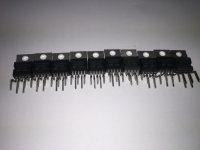Perhaps there is a confusion between guaranteed (ie tested) min/max parameters and "typical" values (ie not 100% tested)?
Relying on typical values is asking for trouble.
Relying on typical values is asking for trouble.
Most datasheets at least for some parameters will state Min, Typ & Max.
The 2n3773 for instance states 100% testing for Pmax 150W @ 100Vce.
That makes the 150W a min value.
The 2n3773 for instance states 100% testing for Pmax 150W @ 100Vce.
That makes the 150W a min value.
If any of you guys is familiar with tda 2050-51, let me know if these look authentic or not.
thanks
I've purchased a few TDA2040 and 2050 chips at different times from DigiKey or Mouser. Where the pins enter the epoxy are thicker like the one in your photo 4th over from the from the right. I think they would be the same for the 2051's as well. Also, the semi circle scoops on the sides are out of position with the fake ones. ST micro discontinued all these ICs a couple years ago and they vanished from the reliable suppliers within days. I think most of yours are counterfeit.
Last edited:
thanks john66.
i did not buy them yet, this is actually a picture which the electronic component store sent me. Can you post a picture with one of your tda2050 ?
if you have any left , of course.
thanks
i did not buy them yet, this is actually a picture which the electronic component store sent me. Can you post a picture with one of your tda2050 ?
if you have any left , of course.
thanks
thanks john66.
i did not buy them yet, this is actually a picture which the electronic component store sent me. Can you post a picture with one of your tda2050 ?
if you have any left , of course.
thanks
See post #8 in this thread. The center IC is a real 2050 (the right IC is a real LM1875). Note the thinner legs and scoop positions on the sides of the counterfeit.
I know of no reliable source for the TDAs. Why not use the LM1875? It is the better IC for a few reasons. Better distortion performance, better clipping characteristics and less intrusive current limiting with reactive loads. May the TDA's RIP.
I've opened an LM1875 which was giving me a DC offset of 20V 😱
Now i'm not saying this one is a counterfeit, however my pcb/circuit was good, so could also be just bad luck.
What do you guys think? Unfortunately i was not able to keep the die intact. @johnr66 how did you manage to get that off so clean?
The die size is 2.7mm by 3.7mm
An externally hosted image should be here but it was not working when we last tested it.
Old thread but I was able to decap an authentic LM1875 and get the die measurements. It matches your measurements exactly. So here is what I have (length and width rounded to nearest 10th of a millimeter):
Fake TDA2040 2.2 x 1.8 = 3.96 mm^2
real TDA2040 3.2 x 2.6 = 8.32 mm^2
real LM1875 3.7 x 2.7 = 9.99 mm^2
So an authentic LM1875 has a die area that about 2.5x the area of the die they are putting in some counterfeit parts.
- Status
- Not open for further replies.
- Home
- Amplifiers
- Chip Amps
- Counterfeit IC die revealed!
